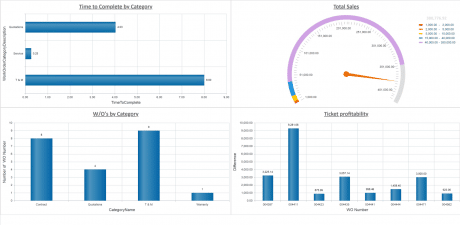Last Updated on February 4, 2024

Owning or managing a construction contractor business keeps you busy around the clock. So how can you keep up with industry changes in order to stay profitable and competitive? As the construction industry evolves, so do the stats and trends and so do the ways in which you will need to pivot your business to avoid getting left behind.
Today, we’re here to share 34 up-to-date contractor statistics to highlight the current state of the construction industry. Below, you will find everything you need to know about industry growth, worker demographics, and significant challenges that contractors are facing today.
We’re also sharing the best way for your construction contractor business to adapt to these trends. By the end of this article, you will know exactly how your business can stay ahead of the curve in the ever-changing construction industry.
Construction Industry Growth
On a global scale, the construction sector is forecasted to experience continued growth markers as it aims to keep up with the demands of the growing population residing in cities across the world. Expansions for commercial construction and public sector projects factor into the following construction industry statistics.
- By 2024, the global construction industry is expected to reach $11,093.7 billion [PR Newswire]
- By 2030, the global construction industry could reach total spending of $17.5 trillion [PR Newswire]
- In Canada, the total spending for new construction projects shows further growth with an expectation to reach $338.8 billion USD in 2023 [Statista]
- In 2020, private sector construction spending in the U.S. reached $1.11 trillion [Statista]
- To sustain an expected population of 7 billion people living in cities by 2050, the construction industry needs to build 13,000 buildings worldwide every day until then. [Redshift]
Construction Revenue
Due to the pandemic, the construction industry has seen numerous shifts in revenue. While some areas are seeing revenue declines, others expect continued growth as more enterprises resume their operations.
Despite delays to construction projects over the past few years, the industry still greatly contributes to the economy on both local and global levels. The statistics below cover how much revenue was generated for the U.S., Canada, and globally
- In 2019, global revenue generated by construction contractors was approximately $473 billion USD [Statista]
- Each year, the construction industry creates nearly $1.3 trillion worth of structures, making it one of the major contributors to the U.S. economy [AGC]
- The U.S. construction industry generated $2 trillion in revenue in 2019 [Ibis World]
- In 2018, the construction industry contributed $141 to Canada’s total GDP [Statista]
- Based on collective revenue, the top 40 Canadian contractors generated over $45 billion USD in 2018 [Statista]
- Betchel accumulates an annual revenue of over $25.5 billion, making it one of the largest American construction companies. [Statista]
Construction Costs
Global construction costs will likely continue to rise, making it more difficult for contractors to maximize the profitability of construction projects. Supply chain issues are among the most recent and pressing issues stemming from the pandemic. Challenges such as sourcing material or hiring skilled workers could hinder new projects and put existing ones further over budget.
- When examining global infrastructure projects, 90% are either over-budget or delayed [FMI]
- Softwood timber, copper pipe, reinforcement bars, and structural steel beams have seen price increases of up to 40 (year-on-year) in some markets due to global supply issues [Turner and Townsend]
- The Producer Price Index reported a 17% increase in the price for construction goods in 2021 [U.S. Bureau of Labor Statistics]
Construction Jobs
Compared to the height of the pandemic, unemployment rates are on the decline. The construction industry, in particular, has seen a slight increase in the total labor force.
As we explain later, the nature of construction projects and jobs are also changing as new technologies are being implemented, potentially affecting the types of jobs available.
- In November 2021, 7.5 million workers were employed in the U.S. construction industry. Employment has almost reached pre-pandemic numbers [Construction Dive]
- Between 2020 and 2030, construction and extraction occupations are expected to gain over 400,000 new jobs in the U.S. [BLS]
- Within the construction industry, construction laborers made up the highest percentage, with 827,100 employed in 2020 [BLS]
- In the U.S., the average hourly employee earning for January 2022 is $33.80 [BLS]
Construction Worker Demographics
The effort to recruit a broader demographic of skilled workers is one challenge contractors face. With construction companies seeing a higher average age within their workforce, this could also cause future challenges that we will go into further detail under the challenges section of this article.
The overall construction workforce is still mainly comprised of primarily Gen X men (born between 1965-1980). Women are slowly taking on roles in the industry, with a slight rise in women-owned construction firms. However, the gap still largely remains.
- At 45.5%, Gen Y (born between 1981-1996) accounts for nearly half the construction industry. [JBK]
- As of 2022, 87% of the construction industry are men, and 13% are women. [BuildForce Canada]
- The total industry labor force in Canada is 1.5 million as of January 2022, which is up 1.19% year-over-year. [BuildForce Canada]
- In the U.S., women make up 10% of the total construction workforce. [BigRentz]
- Of the total amount of construction firms, 13% are owned by women [NSSI]
Safety for Construction Companies
Worker safety should be a top priority for all industries. With the construction industry being high risk, construction-related injuries are incredibly costly. Below are some statistics on just how much money is spent on claims per year. Many workplace injuries can be avoided with sufficient technological updates, mitigation efforts, and worker training.
- Over $170 billion is spent on total workplace injury costs per year, with construction ranking within the top ten most costly [NSC]
- In the U.S., $2.5 billion is spent on workers’ compensation claims for nonfatal falls [Liberty Mutual]
- Of construction-related accidents, over 60% occur within an employee’s first year on the job [BLS]
- While construction workers make up 6% of the U.S. labor force, 1 in 5 deaths among workers are in the construction industry [OSHA]
New Construction Technology

As we can see, injuries experienced by construction workers come with a hefty price tag. Mitigating worker threats by using the latest innovation in technology will improve both safety and efficiency on job sites.
When looking ahead, the industry is looking into further investment in wearable technologies.
On top of that, robots could help minimize these costs related to workplace injury. By having robots do risky or unsafe work previously done by construction workers, the construction industry could see significant savings regarding time and money otherwise spent on supporting an injured worker.
Another example of technology adoption in the construction industry is the use of drones. Drones can be used to improve a worksite’s overall operation. 3-D mapping of a worksite allows contractors to see a detailed aerial view, allowing for planning potential challenges that may arise during the project. Because it provides higher accuracy, drones can help contractors save money.
Finally, many contractors find that implementing software improves productivity and decreases human error. With software companies continuing to fine-tune their programs, the number of industry professionals using software solutions is expected to increase.
Here are some early statistics on how new technology will shape the future of the construction workforce.
- Approximately 42.6% of constructions firms are in the process of experimenting with drones [JBK]
- Over 10% of workers report using a smartwatch device for work [JBK]
- At an estimated value of more than $1.2 trillion, the global AR (augmented reality) market is helping construction professionals use AR technology for hazard simulation and safety training [PR Newswire]
- Among contractors, 82% believe that BIM (Building Information Modeling) is the future of project information [NBS]
- By 2035, AI could increase the construction industry’s profits by 71% [Accenture]
- By 2025, the global smart city market is expected to reach $2.5 trillion [Business Wire]
- In a U.S. survey, 70% of contractors agreed that advanced technology increases productivity [USG + U.S. Chamber of Commerce]
- 61% of respondents believe building information modeling (BIM) processes reduced project error, and 55% reported a reduction in communication time [(Dodge Data and Analytics]
- 2 out of 5 construction industry professionals had plans to either purchase or upgrade their construction management software in 2018 [financesonline]
Construction Firm Challenges
A labor shortage could be one of the significant challenges that contractors will face in the coming years. A lack of younger workers means firms are having trouble finding skilled workers once older workers retire.
Low productivity is another industry issue that can be attributed to industry professionals spending time on non-productive activities such as searching for project information or reworking mistakes.
In addition, construction firms report technological barriers as some of their biggest challenges. Lack of adequate technology could result in lower productivity levels or worksites with safety and security issues that could otherwise be addressed with technology.
- In the U.S., 90% of contractors fear a possible labor shortage [US Chamber]
- A “lack of IT staff” hinders 38.2% of companies from adopting new technologies. [JBK]
- 67% of survey respondents in the U.S. reported having trouble hiring carpenter professionals, highlighting the problems of finding skilled labor [Statista]
- The U.S. construction industry spent over $177 billion in labor costs attributed to non-productive activities in 2018 [Autodesk + FMI]
- Construction workers spend an average of over 14 hours per week on non-productive activities [Autodesk + FMI]
Final Takeaways

The statistics above are in constant flux. Still, we hope they give you a better idea of the latest industry findings.
In summary, although the pandemic has disrupted the supply chain and influenced pricing on materials, the lifting of local restrictions has resulted in an increase in job availability. However, the skilled labor shortage remains an industry issue.
Additionally, to reduce the number of workplace-related injury claims per year, companies are now looking toward wearable technology to keep their workers safe. Robots, drones, and smart technology are also leading the way toward technologically advanced worksites while an increasing number of contractors are starting to adopt software to improve efficiency and profitability.
Finally, the recruitment process continues to be a challenge for contractors. Education and outreach programs for the younger generation will be vital to keep up with upcoming project demands. Reducing barriers for women to enter the industry is another area that should be addressed.
Jonas Construction Can Help You Keep Up With Construction Industry Growth & Trends
Increases in economic activity are mirrored in the expansions of construction projects around the globe. Now that we’ve gone over these industry statistics, here’s how you can use them to your advantage.
As we mentioned earlier, contractors are currently faced with challenges such as low productivity, a shortage of skilled workers, and rising material costs while dealing with extraordinary industry growth. If your business can’t overcome these challenges, you’ll lose out to other contractors who can. One of the best ways to address challenges and keep up with rising demands is to eliminate tedious, manual work by investing in construction management software.
Jonas Construction is an industry-leading ERP software that can help you complete projects more efficiently, cut out unnecessary manual processes that are costing you time and money, and gain better insight into your data so you can find key areas to maximize your profits.
Let us help your contractor business increase efficiency, productivity and profitability to keep up with the growing and ever-changing construction industry. Contact us today or request a demo to learn more about how Jonas can support you.





